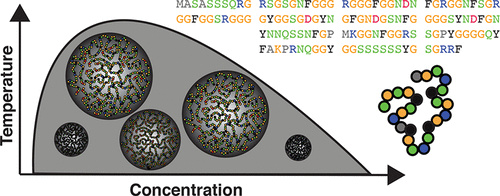当前位置:
X-MOL 学术
›
Biochemistry
›
论文详情
Our official English website, www.x-mol.net, welcomes your
feedback! (Note: you will need to create a separate account there.)
Relationship of Sequence and Phase Separation in Protein Low-Complexity Regions
Biochemistry ( IF 2.9 ) Pub Date : 2018-03-08 00:00:00 , DOI: 10.1021/acs.biochem.8b00008 Erik W. Martin 1 , Tanja Mittag 1
Biochemistry ( IF 2.9 ) Pub Date : 2018-03-08 00:00:00 , DOI: 10.1021/acs.biochem.8b00008 Erik W. Martin 1 , Tanja Mittag 1
Affiliation

|
Liquid–liquid phase separation seems to play critical roles in the compartmentalization of cells through the formation of biomolecular condensates. Many proteins with low-complexity regions are found in these condensates, and they can undergo phase separation in vitro in response to changes in temperature, pH, and ion concentration. Low-complexity regions are thus likely important players in mediating compartmentalization in response to stress. However, how the phase behavior is encoded in their amino acid composition and patterning is only poorly understood. We discuss here that polymer physics provides a powerful framework for our understanding of the thermodynamics of mixing and demixing and for how the phase behavior is encoded in the primary sequence. We propose to classify low-complexity regions further into subcategories based on their sequence properties and phase behavior. Ongoing research promises to improve our ability to link the primary sequence of low-complexity regions to their phase behavior as well as the emerging miscibility and material properties of the resulting biomolecular condensates, providing mechanistic insight into this fundamental biological process across length scales.
中文翻译:

蛋白质低复杂度区域中序列和相分离的关系
液-液相分离似乎在通过生物分子缩合物形成的细胞区室化中起关键作用。在这些冷凝物中发现了许多具有低复杂度区域的蛋白质,它们可以在体外进行相分离。响应温度,pH和离子浓度的变化。因此,低复杂度区域可能是在响应压力而介导分隔过程中的重要角色。但是,人们对它们的氨基酸组成和图案如何编码相行为的了解却很少。我们在这里讨论聚合物物理学为我们理解混合和解混合的热力学以及如何在主序列中编码相行为提供了一个强大的框架。我们建议根据其序列属性和相位行为将低复杂度区域进一步分类为子类别。正在进行的研究有望提高我们将低复杂度区域的主要序列与其相行为以及所产生的生物分子缩合物的新兴混溶性和材料性质联系起来的能力,
更新日期:2018-03-08
中文翻译:

蛋白质低复杂度区域中序列和相分离的关系
液-液相分离似乎在通过生物分子缩合物形成的细胞区室化中起关键作用。在这些冷凝物中发现了许多具有低复杂度区域的蛋白质,它们可以在体外进行相分离。响应温度,pH和离子浓度的变化。因此,低复杂度区域可能是在响应压力而介导分隔过程中的重要角色。但是,人们对它们的氨基酸组成和图案如何编码相行为的了解却很少。我们在这里讨论聚合物物理学为我们理解混合和解混合的热力学以及如何在主序列中编码相行为提供了一个强大的框架。我们建议根据其序列属性和相位行为将低复杂度区域进一步分类为子类别。正在进行的研究有望提高我们将低复杂度区域的主要序列与其相行为以及所产生的生物分子缩合物的新兴混溶性和材料性质联系起来的能力,











































 京公网安备 11010802027423号
京公网安备 11010802027423号